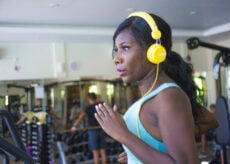Full-Body, 4-Week Single Kettlebell Workout (see the video)

When it comes to getting in a quick but intense workout, one that you can easily do at home and that works your whole body, well, it’s hard to beat a full-body kettlebell workout.
If you’re bored with your workouts lately and you’ve been feeling less than motivated, you might really enjoy kettlebell training. This kind of workout is a welcome change to the usual dumbbells, machines, bands, classes, and outdoor sports like walking, running, and biking. While all of these exercises are great and can certainly get the job done, doing them day in and day out can get really old, really fast. Instead, why don’t you try mixing it up and throwing your body a curveball with a kettlebell workout?
What is a Kettlebell?
A kettlebell is an iron or steel ball with a large, thick handle affixed at the top. Originally part of a farmer’s toolbox, these odd objects were used to measure the weight of grain. However, over time, their value as a strengthening and conditioning aid caused their utilitarian use to blossom into more as they became part of a fitness movement.
To use a kettlebell for a workout, you simply grasp the handle with either one or both hands and lift or swing the ball based on the workout plan you’re following. The unusual shape of a kettlebell throws off the center of gravity for this popular exercise prop. And, since its unique shape offsets gravity, a kettlebell offers a distinctive workout that helps not only strengthen the whole body, across the board, but improves your cardiovascular system as well.
While the kettlebell won’t win any beauty pageants and is not known for its cutting-edge design, the functionality of a kettlebell can’t be questioned. Kettlebells have become the tool of choice for many fitness enthusiasts who swear the benefits outweigh those provided by exercising with more mainstream/boring equipment like dumbbells or machines.
Benefits of a Kettlebell Workout
Because of its unique shape and offset center of gravity, a kettlebell virtually forces you to use stabilizer muscles, tendons, and ligaments, in addition to the normally expected muscle groups to move the weight. And, the fact that your whole body is engaged in moving the kettlebell means you’ll burn a lot of extra calories in the process.
- Works stabilizer muscles—due to the offset nature of the kettlebell, you’ll need to engage stabilizer muscles, in addition to the main muscle movers, to properly lift and manipulate the weight.
- Strengthens more than just muscles—yes, the kettlebell will certainly help you get stronger, but you’ll also notice better grip strength and core strength as well as stronger wrists, arms, shoulders, knees, and hips over time.
- Aids in flexibility—along with strength, you’ll notice increased flexibility as you bend and move against gravity with ballistic movements.
- Provides exercise across the board—enjoy cardiovascular conditioning, weight loss, increased endurance, and strength when you do full-body kettlebell workouts on the regular.
Try This Full Body, Single Kettlebell Workout from Coach Tim
If you’re ready to give it a shot yourself, Coach Tim has put together a quick full-body kettlebell workout you can do in the privacy of your own home or backyard.
While the initial workout can be done over the span of two, four, or even six weeks, this workout program also provides the added flexibility of ramping up its intensity by adding weight and/or reducing rest periods over time as you get stronger and become more conditioned.
The Workout
Overview: You will swing the kettlebell for 30 seconds. Next, you’ll go into a split kneel press and do eight presses on the right side. Then, get back up on your feet for eight goblet squats, back down for eight more split kneel presses for the left side, and you’ll finish off with a carry.
You’ll take a few minutes rest and then do the sequence again. Perform the entire routine three times to complete your first workout. Over time you can add weight to the movements, cut back on rest times, or add other kettlebell sequences.
1. Swing—begin by standing with your feet a little wider than hip-width apart. Grasp the kettlebell with both hands and stand upright. Next, bend your knees while simultaneously swinging the kettlebell backward between your knees. Allow the kettlebell to naturally swing forward again, and as it does, push up through your hips and knees to straighten your legs while forcing your arms straight out in front of you and bringing your torso back to an upright position. Continue to allow the kettlebell to swing back and forth from the front to the back of your body while bending at the torso and knees.
2. Split Kneel Press—start by kneeling on your right knee. Grasp the kettlebell with your right hand and bend your arm to bring the kettlebell up to your shoulder. Straighten your arm fully to bring the kettlebell overhead before lowering it again in a controlled motion. Repeat this movement eight times for each side.
3. Goblet Squat—start by grasping the kettlebell from the top with both hands. Place your feet slightly wider than hip-width apart. As you get ready to bend your knees to squat down, bring the kettlebell up to your chest by bending your elbows. Hold the kettlebell at chest level as you perform eight goblet squats, dropping your hips low in between your legs for every repetition before exploding upwards to standing.
4. Carry—simply grasp the kettlebell with your right hand and carry it a pre-determined distance. Either come back to the start or switch hands midway and carry back to start. Repeat on the opposite side if necessary.
As mentioned, start by running through the entire workout one time. Build up to multiple run-throughs over time and add weight when appropriate to increase the intensity and difficulty of the workout.




